The Role of Cat Trees in Feline Behavior

You may have noticed your feline friend’s fascination with heights and their insatiable urge to explore vertical spaces. Ever wondered why cat trees hold such significance in their behavior? The answer lies in their innate instincts and the ways these structures cater to their needs. Understanding how cat trees influence your cat’s behavior can provide valuable insights into fostering a harmonious environment. So, let’s explore the intriguing world of cat trees and their impact on our feline companions’ daily lives.
Natural Instincts and Climbing Behavior
When observing cats, their natural instincts often lead them to exhibit climbing behavior. Cats have an innate desire to explore their surroundings from higher vantage points. This behavior stems from their ancestral roots as hunters and predators in the wild. Climbing allows cats to survey their environment, escape potential threats, and establish territories.
Cats are skilled climbers due to their flexible bodies, sharp claws, and strong muscles. Their ability to scale trees, furniture, or cat trees with agility is a testament to their natural climbing prowess. Climbing also provides cats with mental stimulation and physical exercise, helping to prevent boredom and obesity.
In a household setting, understanding a cat’s instinctual need to climb is crucial for providing appropriate environmental enrichment. Cat trees, shelves, or vertical spaces in the home can satisfy this instinct and promote a cat’s overall well-being. By offering vertical territory, cat owners can create a stimulating environment that aligns with their feline companion’s natural behaviors.
Importance of Vertical Territory
To enhance your cat’s well-being and behavioral fulfillment, providing vertical territory is essential in a household setting. Cats have a natural inclination to seek out high vantage points as it allows them to observe their surroundings, feel safe, and fulfill their instinctual need for vertical space. By incorporating cat trees or shelves at different heights in your home, you’re offering your feline companion opportunities to climb, perch, and retreat to elevated spaces. Vertical territory not only promotes physical exercise but also supports your cat’s mental stimulation and emotional security.
Having vertical territory helps reduce stress and conflicts in multi-cat households by providing individual spaces for each cat. It allows them to establish hierarchies and maintain a sense of control over their environment. Additionally, vertical spaces can serve as escape routes in case of perceived threats or stressful situations, enabling your cat to feel more secure and confident in their surroundings. Overall, by recognizing the importance of vertical territory for your cat, you can create a more enriching and harmonious living environment for your feline friend.
Benefits of Scratching Opportunities
Providing designated scratching areas is crucial for your cat’s physical and emotional well-being. This practice encourages natural behaviors and helps maintain healthy claws. Cats have an innate need to scratch to stretch their muscles, relieve stress, and mark their territory with scent glands located in their paws. By offering appropriate scratching surfaces like cat trees, you help fulfill these needs while protecting your furniture from damage.
Having scratching opportunities can also help prevent behavioral issues such as aggression or anxiety in your cat. Scratching provides an outlet for pent-up energy and helps them feel secure in their environment. Additionally, regular scratching can help keep your cat’s claws healthy and trimmed, reducing the risk of ingrown nails or other claw-related problems.
When selecting a cat tree for scratching, opt for sturdy structures covered in materials like sisal rope or carpet that mimic tree bark. Place the cat tree in a prominent location to entice your cat to use it regularly.
Creating Safe and Restful Spaces
Encouraging your cat to feel safe and find restful spaces within your home is key to their overall well-being and contentment. Cats are naturally inclined to seek out cozy spots where they can relax and unwind. Providing comfortable bedding in quiet areas of your home, away from high-traffic zones, can help create a sanctuary for your feline friend. Consider placing a soft blanket or a cat bed in a secluded corner or near a sunny window where they can bask in the warmth of the sun.
Additionally, incorporating cat trees or shelves at different heights can offer your cat elevated resting spots that mimic their natural instinct to perch and observe their surroundings. These elevated spaces not only provide a sense of security but also allow your cat to survey their territory from a safe vantage point. Ensuring that these spaces are stable and sturdy will further enhance your cat’s feeling of safety and comfort in your home.
Encouraging Mental Stimulation
How can you engage your cat’s mind and promote mental stimulation for a happier and healthier feline companion? One effective way is by incorporating interactive elements into your cat tree. Choose a tree with various toys attached at different levels to encourage play and exploration. Rotating these toys regularly can maintain your cat’s interest and prevent boredom. Additionally, consider placing treats or catnip on different platforms to entice your cat to climb and hunt for rewards.
Another way to encourage mental stimulation is by providing perches at different heights with a view of the surroundings. Cats love to observe their environment from a high vantage point, stimulating their natural hunting instincts and curiosity. You can also introduce scratching posts or surfaces throughout the tree to fulfill your cat’s need to sharpen their claws and mark their territory.
Trending Products










